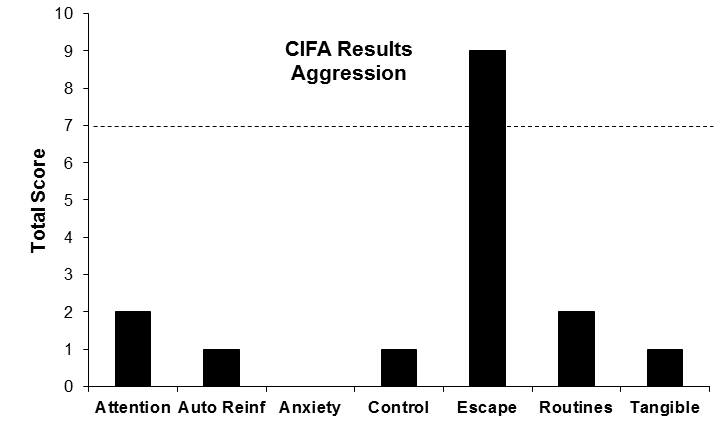What is a BIP?
A Behavior Intervention Plan (BIP) is a document that outlines the protocol to be followed by the treatment team for a child’s challenging behavior (e.g., tantrums, stereotypy, aggression, self-injury,
etc.). The BIP is an important document. It is the means by which the treatment team ensures consistency in the implementation of procedures for a child’s challenging behavior. Without consistency, challenging
behavior will not go away. The BIP also ensures the safety of the child and others in his/her environment by having a plan for how the team will handle the challenging behavior in advance.
What is the purpose of the BIP Builder?
The BIP Builder was created to provide a tool for anyone responsible for the behavioral intervention of a child with Autism Spectrum Disorders (ASD). The purpose of the tool is to provide an efficient
and effective means for writing BIPs for children with ASD. All procedures in the BIP Builder are based on evidence-based practices and emphasize least intrusive procedures. You can build a BIP through
our easy process:
- Answer a series of simple questions.
- Select antecedent modifications, replacement behaviors, and consequence manipulations.
- Customize the BIP.
- Store for easy access and update
as needed.
How does a BIP work?
The BIP is based on the A-B-C model in Applied Behavior Analysis (ABA), which assumes that challenging behavior is not a part of the child’s diagnosis, but is rather, a result of his/her environment.
The A-B-C model includes:
- A = Antecedent: what is happening before the challenging behavior occurs.
- B = Behavior: the challenging behavior in which the child is engaging.
- C = Consequence: everything that happens
after the challenging behavior occurs.
This model assumes that a child’s challenging behavior is more likely to occur under certain conditions or in certain contexts (Antecedents) and that the consequences of the challenging behavior affect
the future likelihood of the challenging behavior occurring again (Consequences).
Based on this model, the BIP contains three sections:
- Antecedent modifications list what preventative measures the treatment team will conduct in order to reduce the likelihood of the challenging behavior occurring to begin with; these are implemented
before the challenging behavior occurs, not as a result of the challenging behavior.
- Replacement behavior is the response that will be taught to the child to be used in place of the challenging
behavior; it takes the place of the challenging behavior best when it communicates the same need that the child is trying to communicate when engaging in challenging behavior.
- Consequence manipulations
list the consequences that the treatment team will deliver immediately after each occurrence of the challenging behavior. This section also lists the positive consequences that will be provided when the
child engages in the replacement behavior.
CIFA
The CARD Indirect Functional Assessment (CIFA) is a tool designed to provide you with information that may help you determine why an individual is displaying a particular challenging behavior (e.g., tantrums,
stereotypy, aggression, self-injury, etc.). In technical terminology, the CIFA is a type of functional assessment, meaning a tool used to identify the function or source of ongoing environmental reinforcement
for a challenging behavior. The results of all functional assessments, particularly indirect assessments, provide only preliminary evidence of the function of behavior. The ultimate confirmation of the
function of a behavior is reached when a treatment based on that function is implemented with integrity and it successfully reduces the individual’s challenging behavior.
The CIFA is a computer-implemented interview, containing a series of 35 questions that are asked of a person who has a large amount of history observing the individual’s challenging behavior. The person
answering the questions on the CIFA can be a parent, teacher, therapist, or anyone else who is very familiar with the challenging behavior. Based on the answers to the questions, a hypothesis can be formed
as to whether one of the following functions may be the reason why the challenging behavior occurs:
- Attention: Gaining attention from others.
- Tangible: Gaining access to preferred items or activities from others.
- Escape: Escape or avoidance of non-preferred tasks or demands.
-
Automatic Reinforcement (“self-stimulation”): The behavior produces its own reinforcement.
In addition to asking questions that refer to the four most common functions of behavior described above, other questions provide information relevant to three additional functions of behavior that are
far less common:
- Routines & Rituals: The behavior allows the individual to engage in routines or rituals or prevents others from interrupting routines or rituals.
- Control: The behavior allows the individual to
be in control of their environment in the moment.
- Anxiety: Anxiety-provoking situations make the behavior more likely to occur, but the behavior is primarily due to one of the other functions described above.
After answering the questions contained in the CIFA, the computer automatically creates a graph that visually displays the results. A clinician who is an expert in functional assessment should then interpret
the results and construct a hypothesis as to which function, if any, is indicated by them. Keep in mind that the functional assessment process is complex, and the results of a single indirect assessment
are rarely if ever sufficient to give a complete picture of the behavior. Additional information must be collected on ecological variables, past treatments that have failed, the setting in which the behavior
occurs, and the family system in which all of these variables are found. Once a sufficient amount of information has been gathered, a behavior analyst who is an expert in conducting functional assessments
must use clinical judgment, along with information from the research literature, to form a reasonable hypothesis regarding the function(s) of the challenging behavior. Nevertheless, in some cases, indirect
functional assessments can provide data that lead to a straightforward, clear functional hypothesis.
Sample CIFA Graph
